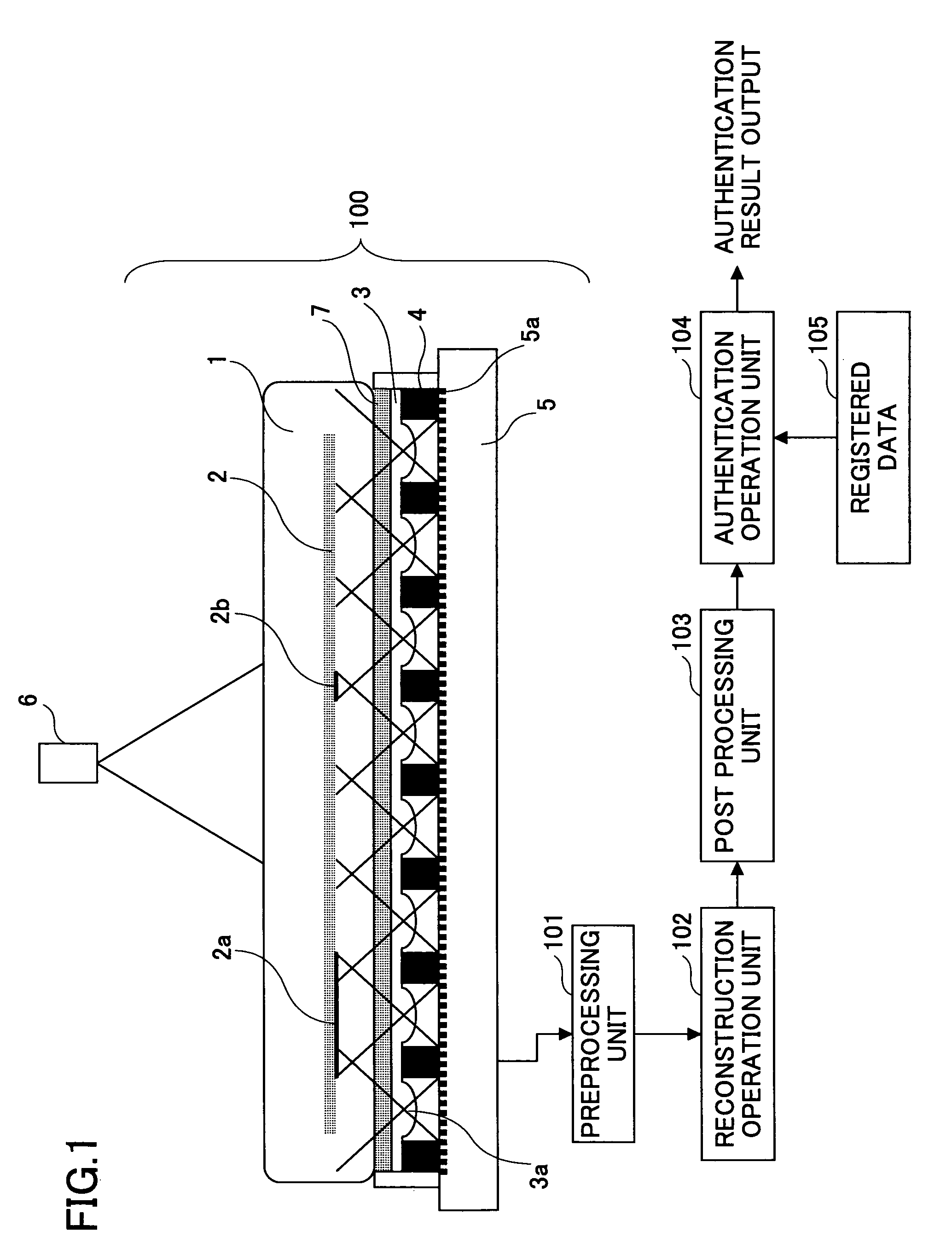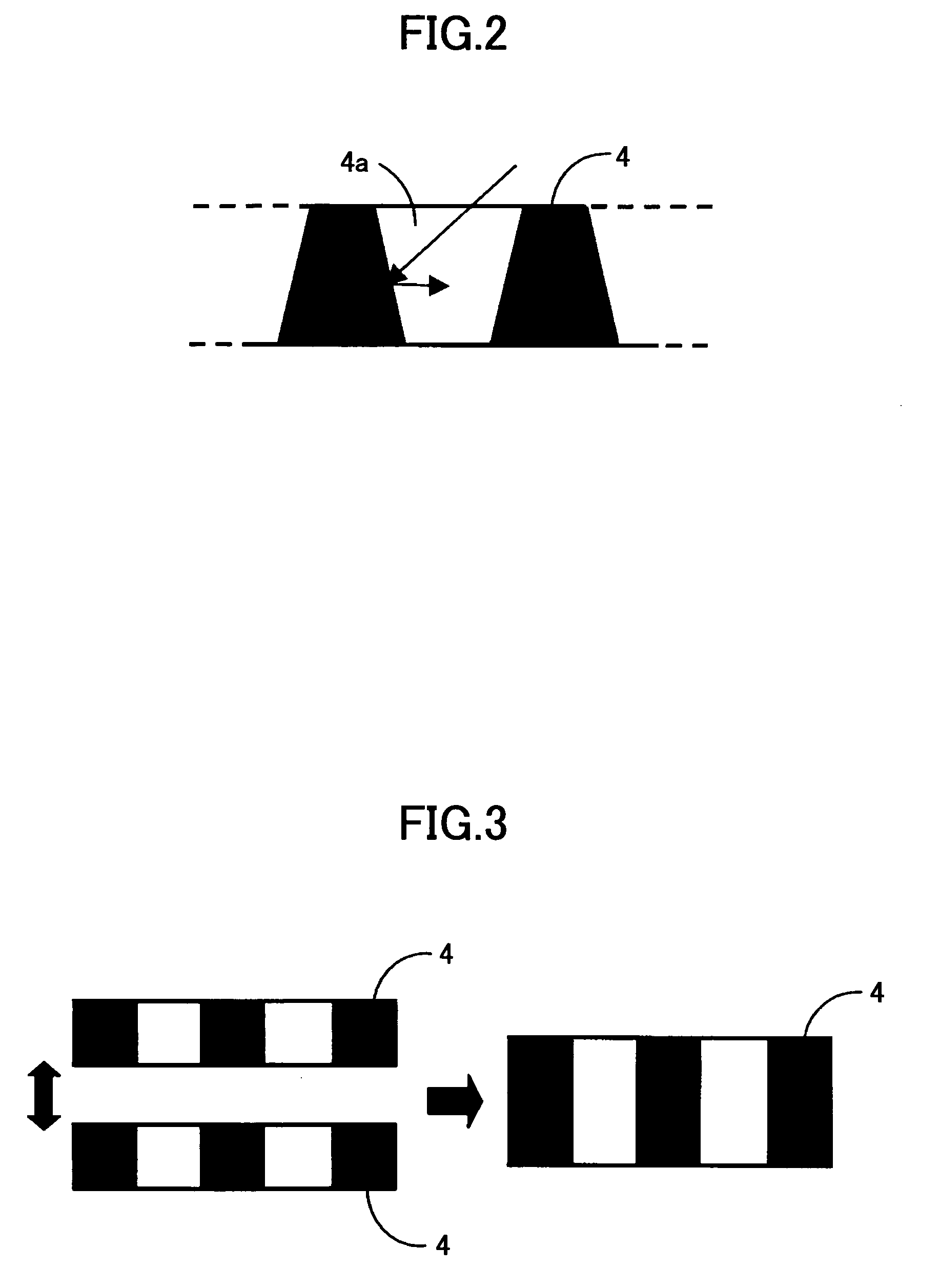Image input apparatus, image input method, personal authentication apparatus, and electronic apparatus
a technology of image input and input method, which is applied in the field of image input apparatus, image input method, personal authentication apparatus, electronic apparatus, can solve the problems of inadequate miniaturization of the apparatus, and achieve the effects of preventing division by zero or noise amplification, reducing the influence of lens positioning errors upon installation of the image pickup device 5, and improving m
- Summary
- Abstract
- Description
- Claims
- Application Information
AI Technical Summary
Benefits of technology
Problems solved by technology
Method used
Image
Examples
first embodiment
[0043]FIG. 1 is a diagram showing an image input apparatus and a personal authentication apparatus according to a first embodiment of the present invention. In FIG. 1, an imaging optical system 100, a preprocessing unit 101, a reconstruction operation unit 102, and a post processing unit 103 make up an image input apparatus. Also, an authentication operation unit 104 and a registered data memory 105 make up an authentication process part that performs a personal authentication process based on a vein pattern. Such an authentication process part and an image input apparatus make up a personal authentication apparatus according to the present embodiment.
[0044]In FIG. 1, a finger (living body) 1 is placed on a certain location of the imaging optical system 100. The imaging optical system 100 captures an image of a vein 2 within the finger 1 as an object, and inputs the captured image. The imaging optical system 100 includes a light source 6, a lens array 3, a light shielding member 4, ...
second embodiment
[0073]FIG. 9 is a diagram illustrating an image input apparatus and a personal authentication apparatus according to a second embodiment of the present invention. The apparatus according to the present embodiment differs from that of the first embodiment in that it includes a correction operation unit 201 and a memory 202 as a correction processing part for correcting (e.g., through MTF correction) image degradation caused by the lenses 3a of the lens array 3. It is noted that other features of the apparatus according to the present embodiment may be substantially identical to the first embodiment. It is noted that optical transfer function (OTF) data pertaining to the plano-convex lens 3a having its convex face facing the image surface are stored in the memory 202 beforehand.
[0074]FIGS. 10A and 10B are graphs illustrating the relationship between the MTF corresponding to the gain of the optical transfer function of a plano-convex lens and the visual angle of an object in a case whe...
third embodiment
[0085]It is noted that the optical transfer function of a lens may vary depending on the object distance (i.e., distance from the object 2 to the lens array 3). Particularly, in an imaging optical system of an image input apparatus according to an embodiment of the present invention where the object is positioned relatively close to the lens array 3, the optical transfer function may greatly vary in response to variations in the object distance.
[0086]FIG. 11 is a graph illustrating exemplary variations in MTF characteristics according to the object distance in a plano-convex lens having its convex face facing the image surface side as in the case of FIG. 10B. Specifically, in FIG. 11, MTF characteristics at a predetermined visual angle when the object distance is equal to A, B, and C are illustrated by a thin solid line, a dotted line, and a dashed line, respectively. As can be appreciated from this example, in a case where variations in the object distance cannot be disregarded (i....
PUM
 Login to View More
Login to View More Abstract
Description
Claims
Application Information
 Login to View More
Login to View More - R&D
- Intellectual Property
- Life Sciences
- Materials
- Tech Scout
- Unparalleled Data Quality
- Higher Quality Content
- 60% Fewer Hallucinations
Browse by: Latest US Patents, China's latest patents, Technical Efficacy Thesaurus, Application Domain, Technology Topic, Popular Technical Reports.
© 2025 PatSnap. All rights reserved.Legal|Privacy policy|Modern Slavery Act Transparency Statement|Sitemap|About US| Contact US: help@patsnap.com



